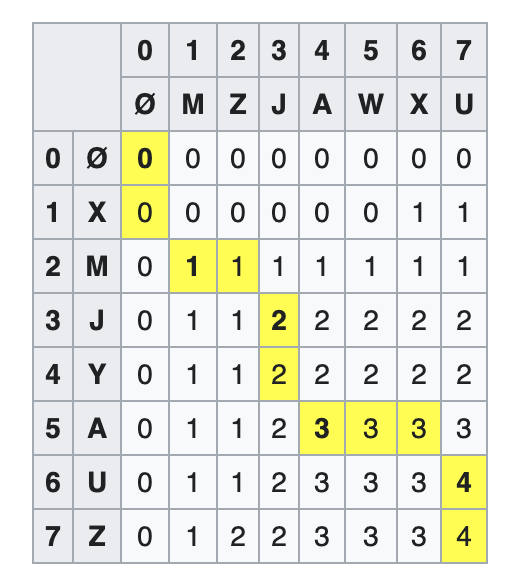Longest common subsequence problem
date: 2021-03-26 excerpt: Longest common subsequence problem(最長共通部分列問題)について
tag: lcslongest common subsequencealgorithmdynamic programming
Longest common subsequence problem(最長共通部分列問題)について
diffコマンドの基幹のアルゴリズム- 2つの列の最長共通部分を見つけるアルゴリズム
- 最小コスト弾性マッチング
- レーベンシュタイン距離
For example, consider the sequences (ABCD) and (ACBAD). They have 5 length-2 common subsequences: (AB), (AC), (AD), (BD), and (CD); 2 length-3 common subsequences: (ABD) and (ACD); and no longer common subsequences. So (ABD) and (ACD) are their longest common subsequences.
具体的な挙動
- edit distance(編集距離)に似た概念であるが、編集距離が最も小さいコストの動的計画法なら、lcsは最もコストの大きい経路を計算する
- 内容が一致したとき、左上(i-1, j-1)のインデックスの値+1

pythonのコード
import numpy as np
def LCS2(s1, s2, n1, n2):
""" Finds the length of the longest common subsequence of two strings
(str, str, int, int) -> (int, 2D-array) """
Matrix = np.zeros((n1+1 , n2+1))
for i in range(1, n1+1):
for j in range(1, n2+1):
if s1[i-1] == s2[j-1]:
Matrix[i][j] = Matrix[i-1][j-1] + 1
if s1[i-1] != s2[j-1]:
Matrix[i][j] = max(Matrix[i][j-1], Matrix[i-1][j])
return (int(Matrix[n1][n2]), Matrix)
例; そのまま
解答
def lcs(s1, s2):
n1, n2 = len(s1), len(s2)
M = [[0]*(n2+1) for _ in range(n1+1)]
for i in range(1, n1+1):
for j in range(1, n2+1):
if s1[i-1] == s2[j-1]:
M[i][j] = M[i-1][j-1] + 1
if s1[i-1] != s2[j-1]:
M[i][j] = max(M[i][j-1], M[i-1][j])
return (int(M[n1][n2]), M)
def solve():
s1 = input()
s2 = input()
size, M = (lcs(s1, s2))
print(size)
N=int(input())
for _ in range(N):
solve()
参考
例; レーベンシュタイン距離
問題
解答
def levenshtein_distance(s1, s2):
n1, n2 = len(s1), len(s2)
dp = [[float("inf")]*(n2+1) for _ in range(n1+1)]
for i in range(n1 + 1):
dp[i][0] = i
for j in range(n2 + 1):
dp[0][j] = j
for i in range(n1):
for j in range(n2):
# 変更操作
if s1[i] == s2[j]:
dp[i + 1][j + 1] = min(dp[i + 1][j + 1], dp[i][j])
else:
dp[i + 1][j + 1] = min(dp[i + 1][j + 1], dp[i][j] + 1)
# 削除操作
dp[i + 1][j + 1] = min(dp[i + 1][j + 1], dp[i][j + 1] + 1)
# 挿入操作
dp[i + 1][j + 1] = min(dp[i + 1][j + 1], dp[i + 1][j] + 1)
return (dp[n1][n2], dp)
def solve():
s1 = input()
s2 = input()
opnum, dp = (levenshtein_distance(s1, s2))
print(opnum)
N,M=map(int,input().split())
solve()